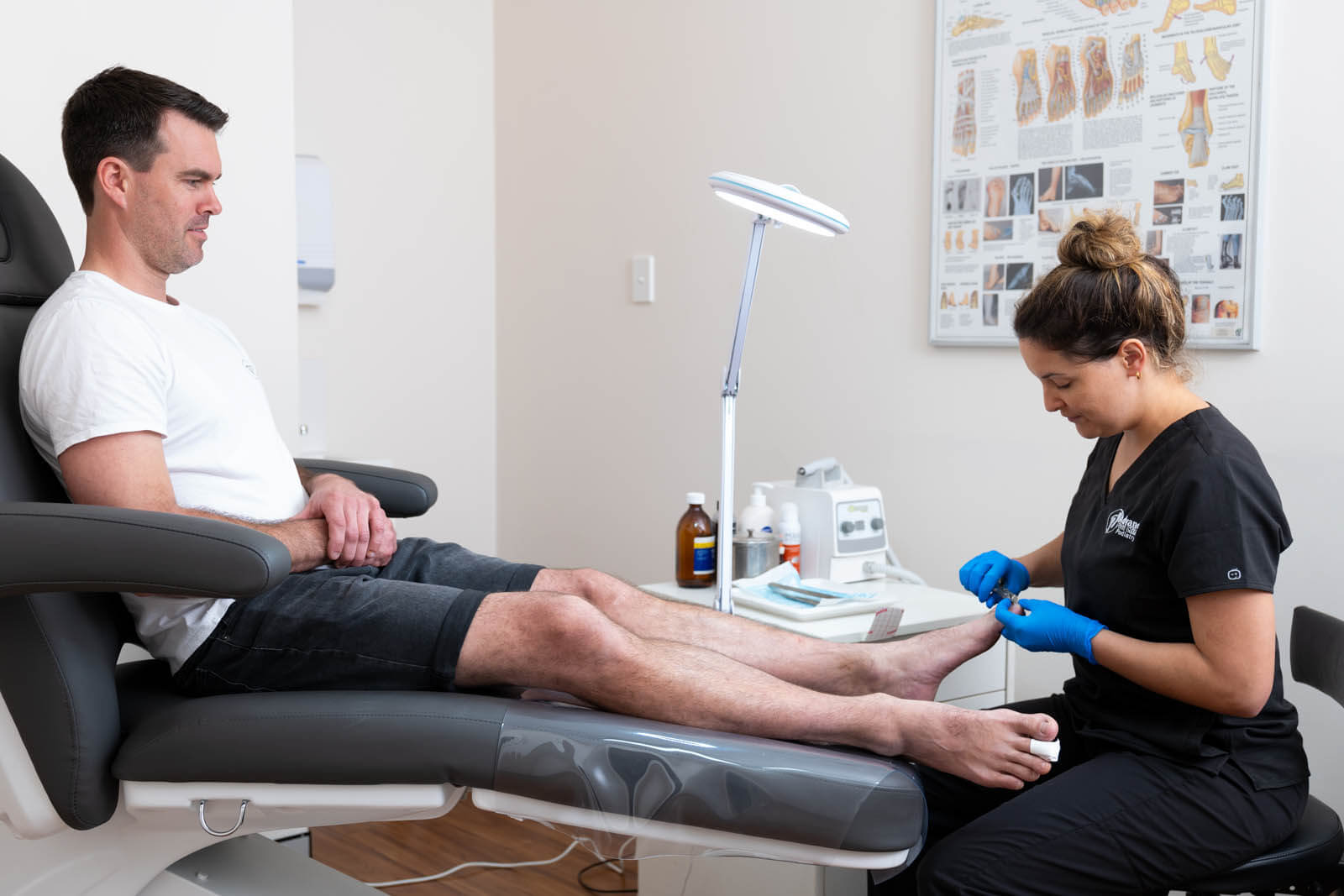Diabetic Foot Care
Diabetic Foot Care
Diabetes is a very common condition. Most people either have it or know someone who does. It affects around 1.8 million Australians. It is no wonder then that diabetic foot care plays such an important role.
Diabetic feet can pose a range of health problems such as diabetic foot ulcers, peripheral neuropathy and peripheral arterial disease. Podiatry for diabetes involves regular screening for the health of nerves, arteries and skin of your feet.
Podiatrists play a crucial role in caring for the health of people with diabetes. With regular care, podiatrists improve outcomes for those living with diabetes. Diabetic foot care should be a regular part of ongoing healthcare for diabetics.

What is diabetes?
Diabetes is a condition that involves abnormal levels of glucose in the blood. When we eat food we consume glucose. It enters the bloodstream and is normally converted to energy by the hormone insulin. In diabetes, the body’s production of insulin is either insufficient or non-existent. So blood glucose levels stay high and energy levels can fluctuate rapidly without insulin to keep them steady.
In type 1 diabetes (10% of diabetes) the body does not produce insulin at all. This is usually detected in childhood. In type 2 diabetes (85% of diabetes) the body becomes gradually resistant to the effects of insulin. Both forms of diabetes require ongoing management.
Diabetes can affect the eyes, heart, kidneys and feet. Podiatrists are concerned with how diabetes affects feet.
The two main ways diabetes affects the feet
Blood supply
Excessive blood glucose levels affect the smaller blood vessels in the body found in our peripheries (feet, hands, eyes etc). Over time these blood vessels become damaged and can no longer pump as much oxygenated blood as before. This leads to poor wound healing, higher risk of developing long lasting infections and tissue death. Impaired blood supply (peripheral arterial disease) is one of the leading contributors to diabetic foot ulcers and amputation.
Nerve function
Nerves are important for both muscle tone and balance along with detecting various sensations. In diabetes, nerves can progressively decline to the point of permanent loss of sensation in the feet. This is called Peripheral Neuropathy. Peripheral neuropathy causes interrupted pain, temperature and touch signals. The body’s way of alerting us when there is something wrong is interrupted. This means there is a much higher risk of injury and deformity occurring.
What is the role of a podiatrist in treating diabetes?
A podiatrist is a lower limb and foot expert. Podiatrists receive special training on the effects of diabetes on the feet.
Complications from diabetes will show up slowly and will first affect parts of the body with smaller nerves and weaker blood flow. This means our feet (which are the furthest from our heart and brain) will usually show problems first.
For this reason it is recommended that anyone with diabetes see a podiatrist a minimum of once a year for the below services.

The two main ways diabetes affects the feet
Neurovascular screening
When you see a podiatrist they will conduct a neurovascular screening on your feet. This is a very important part of caring for diabetic feet. The simple and painless tests will give a good indication of the state of the blood supply and nerve function in your feet. Problems can be detected early. Results reported back to your GP for management. Based on the results of the tests, your podiatrist will tell you how often you should have this neurovascular screening done. At a minimum, it should be repeated once a year.
General foot care
Podiatrists can provide “general foot care” ongoing to diabetic patients. General foot care refers to providing a general foot check, safe cutting of nails, reduction of callus (hard skin), management of fungal, ingrowing or deformed nails, corns and warts. Even if you don’t have any problems, it is recommended that a podiatrist take care of your feet. This way they can provide ongoing monitoring for any issues and ensure that your feet are safely cared for. General foot care can reduce the risk of diabetic foot ulcers.
Diabetic foot ulcer care
A “diabetic foot ulcer” refers to any wound on a diabetic foot which fails to heal. Even small cuts can become ulcers due to the effects of diabetes on tissue healing and heightened infection risk. It is estimated that every year there are approximately 27,600 diabetic foot ulcer related hospital admissions. 4,400 limbs are amputated every year as a direct result of diabetic foot ulcers. Approximately 1,700 people die. Podiatrists play a crucial role in reducing these numbers. Diabetic foot ulcers can be detected early, treated and healed by a podiatrist in private practice most of the time.
Preventative measures
As well as general foot care, podiatrists can also provide further diabetic foot ulcer prevention in the form of custom orthotics, footwear advice and self-care education. Seeing a podiatrist means personalised advice and care for your feet to keep them as safe as possible.
Ready for an appointment?
How do I book an appointment?
It’s easy! Get in touch to book by calling your nearest clinic or emailing info@afootc.com.au. Otherwise, you can simply book online right here.
Do I need a referral?
No! You can choose to see a podiatrist privately either through self-pay or a private health fund (HICAPS is available for on-the-spot claims). Some patients may be eligible for a medicare referral to see a podiatrist.
What do I need to bring to my first diabetic foot care appointment?
At your first appointment you and your podiatrist will go through your relevant medical history with you. It will help to have an up-to-date list of your medications and medical history. With regards to your diabetes, we will ask for your diagnosis date, management strategies, complications and recent test results. Please bring your most recent at-home daily blood glucose level readings, if applicable.
We will also look at your general foot health and any other complaints you may have. To do this it is helpful if you wear or bring your usual footwear (the shoes you wear the most) as well as any shoes you wear for exercising. If you have any related imaging reports (e.g. x-ray, ultrasound), please bring them as well as any referrals you may have.


What can I expect at my initial appointment?
At your initial appointment one of our friendly reception staff will welcome you into the clinic. Your podiatrist will take you into one of our modern treatment rooms and begin by going through your medical history and listening to any concerns you may have.
Once they have a thorough understanding of your health and concerns, your podiatrist will perform a general foot health check and neurovascular screening. This involves carefully examining the skin, joints, nerve function and blood supply of the feet to detect any issues.
Your podiatrist will also safely cut your nails and attend to any callus (hard skin). They will then plan and discuss your ongoing treatment based on your presenting issues, foot health and medical history.
What will my diabetic foot care appointment cost?
For specific information related to appointment fees, contact your nearest clinic. Our helpful reception team will answer any of your questions.
If you are eligible and have a valid DVA Podiatry or Medicare Referral and you have booked a bulk bill appointment, there is no out-of-pocket cost.

Take the first step towards happy and healthy feet.
Ready to give your feet the care they deserve? Book your appointment online or call us and experience our expert podiatry services at any of our six clinic locations.

